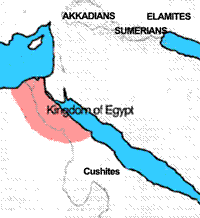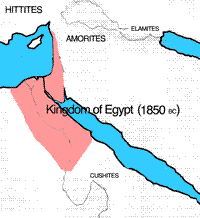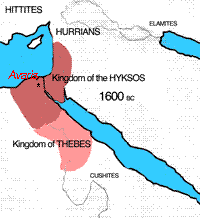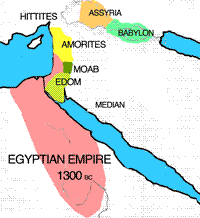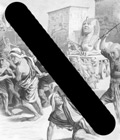The two primary
books of the Old Testament – Genesis and Exodus – refer
to 'Pharaoh' 155 times. Curiously, not once in either book is
Pharaoh identified by name – and yet, in fact,
the references are to many different pharaohs, across many centuries.
The anomaly is all the more telling in that the holy books are
not
lacking
in
naming numerous
sundry and incidental characters. For example, the grandmother,
of the grandmother, of King Asa of Judah was Abishalom, should
you be interested! (1
Kings 15.10). But this style of literature should be familiar
to us all: "Once
upon a time, in a land far away, was a bad king. And in the forest,
David
played
... "
It's called a Fairy Tale.
Out of Egypt
Let's remind
ourselves of Israel's supposed early encounters with the diverse
kings of Egypt. In the sacred history of the Jews, the ‘father of the races’ Abraham
is placed in Babylonia, anachronistically re-labelled Chaldea, a term
more
appropriate to the empire of Nebuchadnezzar in the 600s BC. The character
of Abraham alternates between bedouin pastoralist and landed grandee.
Neither has the slightest claim to historical veracity.
Pimping
Patriarch!
 |
Abraham's
wife Sarah – an irresistible beauty
at 70 |
|
An unnamed (possibly
blind) pharaoh whisked this babe from the
Levant into his harem – and rewarded Abraham
with "sheep, oxen, asses, menservants, maidservants,
she asses and camels."
(Genesis 12.14,15)
|
The nonsense begins
Abraham – and
Unnamed Pharaoh No. 1
To identify
this pharaoh choose any date between 2300 BC - 1400
BC. Abraham's supposed existence hinges exclusively
on biblical sources and working backwards from the
supposed existence of Solomon, several centuries
later.
The Good
Book informs us that there is a 10-year age gap between
Abraham and his wife/half-sister Sarah (Genesis 17.17).
Thus when the Patriarch gets God's call to leave
Haran, Sarah is already a pensioner (he is 75, so
she is 65) (Genesis 12.4.) After wandering in Canaan,
a spate of altar building and camping in the mountains,
famine drives the old fellow and his missus down
into Egypt (Genesis 12.12).
Abraham
fears his wife's "great beauty" will get
him killed so they concoct the ruse that "she's
my sister." Sure enough, Sarah gets fast-tracked
into the harem of 'Pharaoh' – but the duped
king gets a nasty case of plague. Though the trick
is unmasked, Abraham is allowed to leave – with
Sarah and, it seems, with all his ill-gotten gains.
The
Patriarch, his Wives, his Egyptian Slave,
and King Abimelech
Tired
of waiting for her god-promised pregnancy
(she's now 75), Sarah encourages Abraham
to impregnate his compliant slave Hagar (Gen.
16). The result is Ishmael (he
who will father 12 'Arab' princes).
13
years pass in the town of Hebron, during
which time Abraham heads up a military
force to rescue his nephew Lot, captured
by 4 raiding kings (Gen. 14). The invaders
are "utterly routed" near Damascus
(and Abraham gets blessed by the mysterious
priest/king Melchizedek).
In
contrast, when Abraham takes a "sojourn" in
Gerar, the remarkable warrior/sage again
fears Sarah's "great beauty" will
get him killed. For a second time they
employ the "she's my sister" ruse.
King Abimelech takes Sarah into his harem
and Abraham collects another bounty (Gen.20.1,18).
Luckily the Philistine king gets a private
message from God and sends the happy couple
on their way.
The
90-year-old Sarah now gives birth to Isaac,
gets Hagar and Ishmael thrown out the tent,
and lives to the ripe old age of 127 (Genesis
23.2).
Abraham,
137 at the time of Sarah's death, is still
in the prime of life and takes Keturah as
his new wife. She produces for him not
one but six more children. The old goat
does not himself check out until he is
175 years old.* Hmm. |
Isaac doesn't
get to meet a pharaoh. Perhaps the trauma of ritual
abuse when he was a boy made him a bit of a stay
at home. His dad sends a servant out to get him a
wife and when Isaac gets to the 'famine strikes Canaan'
bit his fidelity to Yahweh causes him NOT to go down
into Egypt – the exact opposite of his dad's
behaviour. Believe it or not, Isaac and his wife
Rebekah use the "she's my sister" trick
on the hapless King Abimelech – in Genesis
26.1,14!
Jacob,
trickster son of Isaac, is
the guy who fathers the ancestors of all 12
tribes.
Amazingly,
he also gets to wrestle with God himself! (Genesis
32.24) – hence his new name 'Isra'EL'
('El has conquered'). Jacob gets to Egypt as an
old man. He meets a pharaoh – after his
favourite son Joseph has made the big time. It seems unnamed
Pharaoh No. 2 asks Jacob his
age (a sprightly 130 – and he lives a further 17 years
in 'Goshen'!)
and receives a blessing in return.
Joseph
and Unnamed Pharaoh No. 2: the "Sojourn"
Choose
any date between 1900 BC - 1500 BC for this pharaoh – there's
no evidence that Joseph ever existed either.
Abraham
got to meet the great king of Egypt by having a real
babe as a wife; Joseph (his great grandson) got to
meet Pharaoh by being a real babe himself.
It seems
that the wife of Potiphar, captain of the imperial
guard (who had bought Joseph), got the hots for the
young man – but he was having none of it. Thrown
into prison on a false charge (Genesis 39) he made
a name for himself by "dream interpretation." This,
it seems, is enough to get him catapulted before
the god/king himself.
Once again, an
Egyptian monarch is shown to be amazingly credulous. On
the strength of a 14-year forecast of 'good' and
'bad' harvests the inexperienced, foreign pastoralist
is made Grand Vizier and given command of the world's
most important agricultural economy. Fat chance.
But this – would
you believe – is the foundation stone
of the Hebrew presence in Egypt. Joseph's
reorganised agronomy saves Egypt and a grateful Pharaoh
sends carts to bring Joseph's clan to Egypt:
"all
the souls of the house of Jacob, which came into
Egypt, were three score and ten." – Genesis
45.27.
A handful
of Hebrews take up residence in Egypt, multiply prodigiously,
and – in the familiar story – are first
enslaved then set free. 70 persons arrive and multiply
with a phenomenal, rabbit-like, fecundity to reach
3 million in 215 years – an average of 66 children
per female! (430 years is often quoted but in the
original version of the story – as reiterated
in the Septuagint and by Josephus – half of
that time was spent in Canaan.)
|
Whoa!
Philistine king can't resist 90 year old babe from
Hebron
 |
| Sarah – still
a cracker in her 90s |
|
Abraham repeats
his "she's my sister" scam on King
Abimelech.
This time he collects "sheep, cattle,
men-servants, maidservants ... a thousand pieces of
silver."
(Genesis 20.1,18)

Isaac – childhood
trauma?

A rare photograph
of Jacob wrestling with God (Genesis 32.24).
He names the site 'Peni 'El' (face to face with God!)

Hollywood
keeps the fantasy current |
|
As
nomads, the migratory pattern of the Hebrews might take them
into the Nile Delta. Egyptian forces repeatedly passed through
Palestine to fight wars further north. Any culture the Jews did
not copy from the Babylonians they took instead from the Egyptians.
Tellingly, the huge corpus of Egyptian records contains
no reference at all to Israelites, the Oppression, the Exodus
or Moses.
The hapiru were,
after all, merely bandits on the Canaanite frontier.
The closest
we get to ‘Israelites
in bondage’ is some evidence for Canaanite cities in
the Nile Delta. These almost certainly were established by
that alliance of tribes known as the ‘Sea People’ that
attempted an invasion of Egypt in the 13th and 12th century BC. In
effect, the Jews, bit-players in a history over many centuries, ‘talked
up’ their own ancestral origins by associating themselves
with the major empires and events around them. Probably their
fanciful tale of the fall of Jericho and other Canaanite cities
is a recasting of the invasion of the coastal plain from the
north by the Philistines (unlike themselves, users of iron weapons).

Image of
'Moses' (yes, with horns!)

Horned
god – ubiquitous in Egypt

Horned
cap – mark of an Assyrian king's divinity

Real Ramesses
II (no horns)
"There
had been a need, on the part of 19th century scholars,
to 'find' the Bible in Egypt. They identified Ramesses
II as Pharaoh of the Oppression simply because
they assumed an historical link between Pi-Ramesse
(Ramesses' delta residence) and the store-city
of Raamses (mentioned in the book of Exodus) ...
The
link between Ramesses II and the Israelite Bondage
was an illusion without any real archaeological
foundation."
– Rohl (A Test of Time, p138)
Golden
Calf?
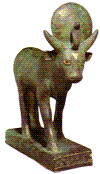
No – Apis
Bull, from the cult centre of Memphis-Saqqara.
The cult reached its zenith towards the end of
pharaonic history. |
|
Egypt
and "Moses" – Fantasy
on steroids
The
hero of the Exodus has an Egyptian not a Hebrew name
(as in Thut’moses, Ah’moses, etc). No contemporary
non-biblical source mentions Moses and the lack of
any external reference in the biblical story makes
it impossible to connect the life of the superhero
with the known history of other cultures.
Baby
Moses and Unnamed Pharaoh No. 3: the "Ethnic
Cleanser"
Choose
any date between 1500 BC - 1200 BC for this pharaoh.
We are not told the name of the pharaoh – but
the Hebrew midwives are 'Shiphrah' and 'Puah'!
In this
unlikely episode, a pharaoh who "does not
know" Joseph is alarmed by the explosive
growth of the Hebrews and decides "hard
labour" will keep them in check (Exodus
1.8,14). Frustrated that this does not work (we
are talking Hebrew virility here) he issues
an order that all the new born male infants of the
Hebrews should be drowned. One is saved in an ark
made of bulrushes daubed with slime. Amazingly, none
other than the daughter of Pharaoh himself finds
the infant mariner and adopts him as her own. But
in true pantomime fashion his own mother is hired
to nurse him.
The
idea of "threatened child becomes great figure" is
commonplace: it was told of Sargon the Great, Heracles,
Romulus & Remus, etc. It is, of course,
reworked in the story of Jesus.
Call
me Mother!
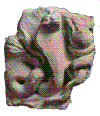
Isis-Thermuthis, a
goddess of fertility and the harvest. (Alexandria,
1st century BC) |
In
the Moses story, we have a foretaste of
the Jesus fantasy itself.
According
to Josephus (Antiquities of the Jews - II.9) pharaoh's daughter is named 'Thermuthis' – a
name which she happens to share with
a manifestation of Isis – which
would make Moses the Horus figure.
Irenaeus
(but not the Christian Bible) reiterates
Josephus' other startling claim: that
God gave the polytheistic Egyptians counsel
to make Moses Generalissimo.
Our youthful
hero "cheerfully" accepted,
rallied the Egyptians and defeated the
Ethiopians who had overrun the entire
country. His victory included vanquishing
a "multitude of serpents" with
the "Ibes" bird.
What a coincidence! In Egyptian mythology, the evil Seth,
in the guise of a snake had bitten the
infant Horus. He had been saved by Thoth – the
Ibis headed god!
In
true fairy tale manner, the Ethiopian
princess saw Moses from the city wall,
fell immediately in love, and brokered
peace for marriage. And they all lived
happily ever after.
Well, not quite
... |
|
Prince
Moses and Unnamed Pharaoh No.
4: the "Oppression"
The youthful
Moses becomes a murderer and fugitive
from justice (Exodus 2.11,15).
Moses flees
to Arabia where he marries the daughter of a Midianite
priest and lives as a shepherd. His father-in-law
is 'Reuel' (Exodus 2.18) or 'Jethro' (Exodus
3.1, 4.18) or 'Hobab' (Judges 4.11) – take
your pick.
After 40
years in Midian, Moses returns to Egypt to make his
famous demand of pharaoh to "let go" (Exodus
5.1) the people he has lived without for 80 years
(Exodus 7.7).
Patriarch
Moses and Unnamed Pharaoh No. 5: the "Exodus"
This pharaoh
is the hard-man opponent of Moses (well, he can't
help it – God himself hardened his heart – Exodus
4.21;7.3 etc.). The whole pageant would collapse
if he had been a softy like pharaohs 1 and 2! Ten
plagues later and Egypt had lost its labour force and
its army (Exodus 14.28). Moses, an octogenarian,
now begins 40 years of wandering.
Salt
crystals in the mummy of Merenptah favoured him
as the drowned 'Pharaoh of the Exodus' – until
it was realised all mummies showed evidence of
these embalming salts!
Oddly enough,
Egypt reached new heights of imperial splendour and
prosperity during the New Kingdom (18th - 19th dynasties).
Tutmosis III campaigned beyond the Euphrates and
reached the Fourth Cataract on the Nile; Rameses
II halted the advance of the Hittites in Syria and
built more temples and monuments than anyone.
Perhaps
those Hebrews hadn't pulled their weight after
all! |
|
Though the colourful
story of the Hebrew Exodus from Egypt is known to everyone
the legend itself is a complete fantasy,
a re-write of a story learned in Babylon. In Exodus, Yahweh
creates a people, not the cosmos:
"Instead
of splitting the carcass of a sea-monster to create the world,
as Marduk did, Yahweh divided the Sea of Reeds to let his
people escape from Pharaoh and the pursuing army. Instead
of slaying the demonic hordes, like Marduk, Yahweh drowned
the Egyptians."
– K. Armstrong, A History of Jerusalem, p31.
In the fantasy 'history'
(chapter 1 of the Book of Numbers) 603,550 'males
of military age' fled Egypt at the time of the Exodus, which
implies a refugee army of at least two million – more than
the total population of Egypt itself! And this multitude supposedly
wandered the wilderness for forty years, contriving to leave
not a trace of their passing for posterity.
Records one historian:
"Despite the
mass of contemporary records that have been unearthed in
Egypt, not one historical reference to the presence of
the Israelites has yet been found there. Not
a single mention of Joseph, the
Pharaoh's 'Grand Vizier'. Not a word about Moses,
or the spectacular flight from Egypt and the destruction
of the pursuing Egyptian
army."
– Magnus Magnusson, The
Archaeology of the Bible Lands - BC, p43.
Not that Egypt had no
impact on the people who were to emerge as Jews in the sixth
century. Jewish
theology is permeated with ideas which had prevailed in Egypt
for millennia. For example, that most hallowed of Jewish
festivals, the Passover, was borrowed from an Egyptian celebration
of the Spring Equinox, of the passing of the sun from south to
north of the equator. Passover, the most important feast of the
Jewish calendar, is celebrated at the first full moon after the
Vernal Equinox, typically occurring on March 21, though it can
fall a day earlier or later.
Many scholars
have seen a link between the sun-worshipping monotheism
of Akhenaten and the Yahweh-worshipping monotheism
of the Jews. Conceivably, expelled priests of the Aten started
the whole thing off. A nomadic people required a portable god.
Though they contrived to make a virtue of their technical inability
to
make
idols, none the less, their sacred texts anthropomorphised
the deity – a human representation of the pharaoh's
sun.
So
humanoid was their god that
initially
they provided
him
with
a
mobile
home, the so-called ‘Ark of the Covenant.' This itself was originally
an Egyptian idea. Paraded about as a lethal protector of
the tribe and a throne for their god, it somewhat lost its importance
when Philistines sacked the settlement of Shiloh and carried
away the Ark as a trophy. It was not replaced. Though nominally ‘invisible’ (and
now homeless!),Yahweh acquired a most man-like countenance.
So!
Shishak? Hophra?
|
Biblical
'Pharaohs' – Unknown to the Egyptians!
Despite
the omission of pharaonic names in Genesis, Exodus
and most other biblical books, in a few places pharaohs
are indeed named. This should have made it possible
to synchronize the real history of Egypt with some
part of the purported "history" of the
Jews recorded in the Bible.
Unfortunately
there is a small problem: the Bible's 'Pharaohs'
are unknown in all of the vast corpus of Egyptian
history.
Thus,
1 Kings (11.40) introduces the character "Shishak";
2 Kings (17.4) brings on "So" ;
and Jeremiah (44.30) gives us "Hophra." The
anomaly has given rise to 200 years of "name
that pharaoh." With many centuries, 30-odd dynasties,
and dozens of monarchs to choose from the possibilities
are endless.
Jeroboam's "refuge" in
Egypt:
Pharaoh 'Shishak' delivers God's punishment
on Judah (1000 - 800 BC)
In the
last days of Solomon, a labourer, promoted to overseer,
called Jeroboam "lifts up his hand" against
the monarch and has to flee to Egypt and the protection
of Shishak (who of course has an open-house for renegade
Jewish labourers) (1 Kings 11). Solomon dies, Jeroboam
becomes king of 10 northern tribes (what a star!)
and Solomon's legitimate heir Rehoboam is left with
just 2 tribes in the south. Jeroboam's accommodating
monarch Shishak plunders the Temple in Jerusalem,
controlled by his rival, and conquers the whole of
Judah. We never hear of Shishak again.
Nothing
is known in Egypt of 'Shishak' but inscriptions of
Pharaoh Shoshenk I (22nd dynasty) record his attack
upon Jerusalem – so Shoshenk has traditionally
been identified as the biblical 'Shishak.'
Hoshea
of Samaria challenges the King of Assyria:
"Pharaoh So" to the rescue (800
-700 BC)
"And
the king of Assyria found conspiracy in Hoshea:
for he had sent messengers to So king of Egypt,
and brought no present to the king of Assyria,
as he had done year by year: therefore the king
of Assyria shut him up, and bound him in prison." – 2
Kings 17.4.
An obvious
candidate for So is Shoshenk – but he's already
identified with Shishak! Thutmose III has a temple
relief showing conquered cities of Judaea – perhaps
we should make Thutmose 'Shishak' so that 'So' can
be Shoshenk?!
Egyptian
civil war written into the story:
Pharaoh 'Hophra' gets on the wrong side of
the Lord
"Thus
saith the LORD; Behold, I will give Pharaoh
Hophra king of Egypt into the hand of
his enemies, and into the hand of them that seek
his life; as I gave Zedekiah king of Judah into
the hand of Nebuchadnezzar king of Babylon, his
enemy, and that sought his life." – Jeremiah
44.30.
With the
'clue' of Nebuchadnezzar (605 - 561 BC) and an obvious
fate, chief suspect is the grandson of Pharaoh Neckau
who reigned from 589 to 570 BC. This pharaoh died
in a rebellion led by his general and son-in-law
Ahmose. Unfortunately, this pharaoh is actually called Apries (Herodotus
ii.169) and on his monuments as Uah`ab`ra (Wahibre).
Perhaps the Pharaoh used the name 'Hophra' when he
sent letters to the Jews ...?!
The biblical
author was using the literary device of a royal murder
to put an instructive 'prophecy' into the mouth of
'Jeremiah.' His oracle of woe was directed at recalcitrant
Jews, many of whom lived in Egypt and were susceptible
to Egyptian religious practices. |
|
Postscript –
Akenaten
anticipates the Psalms, 1350 BC!
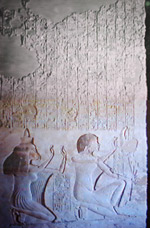
Hymn to the Aten, carved
relief, Tomb of Ay, Armana
Hymn to
the Aten
" Lord of All, Lord
of heaven, Lord of Earth
Thy rays embrace the lands
Thou layest the foundations of the earth
How manifold are thy works!
The ships go down and up the stream..."
|
Psalm 104
"O Lord thou art very
Great
Who coverest thyself with light as a garment
Who laid the foundations of the earth
O Lord how manifold are thy works!
How ships sail to and fro..." |
Sources:
Paul Johnson, A History of the Jews (Phoenix Grant,
1987)
Dan Cohn-Sherbok, The Crucified Jew (Harper Collins,1992)
Henry Hart Milman, The History of the Jews (Everyman, 1939)
Josephus, The Jewish War (Penguin, 1959)
Leslie Houlden (Ed.), Judaism & Christianity (Routledge, 1988)
John Romer, Testament (Viking, 1999)
V. Davies, R. Friedman, Egypt (British Museum, 1998)
Herodotus, The Histories, (Penguin, 1972)
Ahmed Osman, Moses Pharaoh of Egypt (Grafton, 1990)
M. Grant, The History of Ancient Israel (Weidenfeld & Nicolson,
1996)
Aidan Dodson, Monarchs of the Nile (Rubicon, 1995)
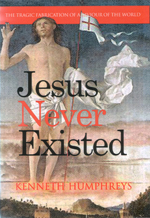
|
 |

|

|
Some fifty articles are now available as a book.
For your copy order:

|
|
|
Copyright © 2004
by Kenneth Humphreys.
Copying is freely permitted, provided credit is given to the author and no material
herein is sold for profit.
|

Fable
Pharaoh
